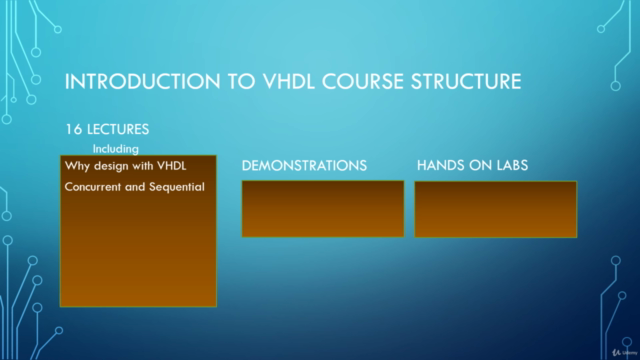Introduction to VHDL for FPGA and ASIC design

Why take this course?
GroupLayout: Introduction to VHDL for FPGA and ASIC Design
From VHDL Basics to Sophisticated Testbench Coding Master the Art of Hardware Description with Expert Scott Dickson 🎓🛠️
Course Description:
Embark on a comprehensive journey into the world of VHDL, the de facto standard for hardware description languages (HDLs) in the field of FPGA and ASIC design. This 12-lecture course meticulously guides you from the foundational elements of VHDL to advanced testbench coding techniques, ensuring a solid grasp of both theory and practice.
What You'll Learn:
- 🏗️ VHDL Basics: Dive into the core concepts of VHDL, including understanding entities, architectures, processes, signals, and variables.
- ⚙️ Sequential vs Concurrent Logic: Gain a deep understanding of the differences between sequential and concurrent logic within VHDL and how they impact your design.
- 🧠 Synchronous Design Methodology: Learn best practices for implementing robust synchronous designs that are crucial for reliable hardware operation.
- 🔍 Simulation Tools Mastery: Get hands-on experience with industry-standard simulators like Altera Modelsim and Xilinx Vivado, enabling you to debug and verify your designs effectively.
Course Highlights:
- Six Lab Projects: Engage in a series of labs designed to solidify your understanding of VHDL concepts through practical application. Each lab is followed by an explanation from Scott Dickson, showcasing his approach to the project and offering insights into professional design techniques.
- Interactive Learning: Combine theoretical knowledge with real-world practice. This course emphasizes learning by doing, ensuring you'll be prepared for any VHDL challenge.
- Live Examples and Demonstrations: Watch over Scott Dickson's shoulder as he tackles each lab, offering a clear example of professional design workflow and problem-solving within VHDL.
- Expert Guidance: Learn from an experienced instructor who has extensive knowledge in the field, providing you with invaluable insights into industry best practices.
Who is this course for?
This course is ideal for:
- Beginners in VHDL looking to build a strong foundation.
- Engineers transitioning from software to hardware design.
- FPGA and ASIC designers aiming to refine their VHDL skills.
- Students pursuing electronics or computer engineering who wish to excel in hardware description languages.
Course Format:
- Video lectures with real-time examples and explanations.
- Interactive lab projects with step-by-step guidance from Scott Dickson.
- Supplementary resources for further study and comprehension.
- Community forum access to discuss challenges and share knowledge with peers.
Join us now and unlock the potential of VHDL in FPGA and ASIC design! 🚀
By enrolling in this course, you're taking a significant step towards mastering VHDL, a skill that will open doors to countless opportunities in the exciting world of FPGAs and ASICs. Sign up today and start your journey to becoming an expert in VHDL for FPGA and ASIC design! 🖥️✨
Course Gallery




Loading charts...
Comidoc Review
Our Verdict
Introduction to VHDL for FPGA and ASIC Design" has earned its strong reputation among Udemy learners. With a practical focus on both theory and hands-on lab experience, the course stands out as an engaging and effective way to learn VHDL programming from scratch or enhance existing knowledge. The instructor's clear explanation and real-world examples help learners grasp complex concepts while maintaining interest throughout the course. However, it would be beneficial for the course creator to address some valid concerns regarding the presentation—namely, providing supplementary materials, polishing overly repetitive lessons, and ensuring a smoother progression through the curriculum.
What We Liked
- Comprehensive exploration of VHDL, taking learners from basics to advanced testbench coding
- Well-designed labs allowing for a hands-on approach, gradually building upon learned concepts
- Experienced instructor providing real-world examples and addressing both do's and don'ts
- Practical and digestible lessons that earned praises from learners coming from various backgrounds
Potential Drawbacks
- Lack of supplementary materials, such as slides or reference material, for note-taking purposes
- Instructor occasionally reads code without providing additional context in certain instances
- Some lessons could benefit from more polish, with users pointing out repetitiveness and uneven progression